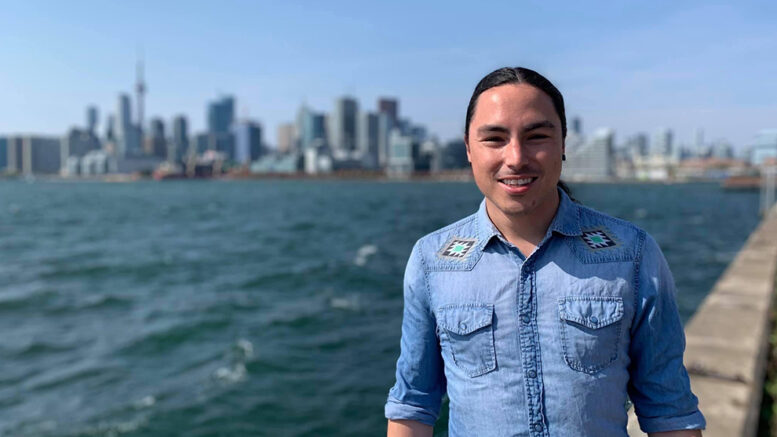By Chevi Rabbit
(ANNews) – The rising rental costs, inflation, and overall cost of living can be hard for Indigenous people. Transitioning from a rural First Nation to an urban setting can be particularly difficult, and at times dangerous. In an interview with ANNews, based on his lived experience, one of Canada’s leading Indigenous journalists, Creeson Agecoutay, offers advice on how to minimize risk and navigate the city landscape.
Agecoutay is 34 years old, a proud Cree man (Nehiyaw Plains Cree) from the Cowessess First Nation in Treaty 4 Territory. When he moved from his rural community of Cowessess First Nation he had to learn some lessons the hard way. He says he often made mistakes but is thankful he persevered and earned a Degree from the University of Regina’s School of Journalism and graduated from the First Nations University of Canada in Regina. He is currently the Atlantic Bureau Chief for CTV National News.
Before joining CTV’s national news team, Agecoutay worked for CTV News Regina as a video journalist in 2008, and in 2013 he was named Host of CTV Saskatchewan’s multiple national and regional RTDNA award-winning series, Indigenous Circle. He became part of CTV’s National News team in 2020.
Mentorship is essential to Agecoutay, and he believes Canada should continue supporting Indigenous journalism. He credits much of his success to Nelson Bird, the former Indigenous Circle and assignment editor for CTV Regina.
And most importantly, he credits his supportive mother for his success as a journalist, Claudia Agecoutay.
Creeson grew up in his home territory of Cowessess First Nation and attended his First Nation School from 1995 to 2005, from grade 2 to grade 12.
“When I graduated high school, I loaded up my car and moved in with my sister in Regina and went to the First Nations University and studied Indian Communications and Arts,” said Agecoutay.
The latest Canadian statistics highlight the growing migration of Canada’s First People to urban cities. Indigenous people began migrating to cities in large numbers in the 1950s. Today, the urban Indigenous population continues to grow. For example, between 2006 and 2016, the number of Indigenous people living in metropolitan areas increased by nearly 60%.
Agecoutay says he did make plenty of mistakes and, at times, put himself in some difficult situations, but he quickly learned to stick to his education to be safe.
To support himself, he acquired a part-time job and took a bus to his classes. “I worked a part-time job at McDonald’s,” said Agecoutay, “and bus passes are a great money saver when going to school.” In addition, cities across Canada have increased public safety on transit due to an increased danger related to substance abuse disorders.
Initially, he lived with his sister, but as soon as his comfort level increased and he got comfortable in his new urban city, he moved into a new place with a roommate. For free furniture or cheap furniture, he recommends sites like Facebook marketplace.
“Facebook marketplace is a great place to start to build your home from scratch,” said Agecoutay.
Indigenous families and young adults also need to educate themselves on tenant rights. Here in Alberta, visit the Landlords and tenants – Rights and responsibilities government website.
“Pay close attention to your landlord; if there are any red flags at all, move on and find another landlord who will appreciate you,” said Agecoutay. “Always check reviews for apartments, and if they have bedbugs, do not move in; bedbugs can be so stressful.”
The stress can ruin your mental health and the rest that you need to stay focused on your goals.
“Living with roommates can save you a lot of money, but you must also put up with their lifestyles,” said Agecoutay. “Choose your roommate wisely.” When you’re in school, a good roommate is one who has the same goals that you have.
A roommate agreement can help clear up any miscommunication. It is a document used when two or more people are moving into a shared space and would like to outline the rights and responsibilities of each person moving in. While a lease agreement covers the rights and responsibilities of the tenants concerning the landlord, it often does not cover the relationships between the roommates themselves.
Agecoutay offers some additional safety tips for successful urban living.
He said, “Don’t put yourself in scary or unnecessary situations by going to parties where you don’t know anyone. If you are going out, make sure you always go out with trusted friends; always watch or protect your drink no matter what.”
Also, likely the most critical warning anyone can ever give a newcomer to an urban city.
“Cab drivers and Uber drivers can’t be trusted with Indigenous customers, so always take pictures of the car you’re getting into, send it to friends or family, and put your fingerprint on the car outside. Cab and Uber drivers have also been known to take advantage of you when you’re under the influence.”
“Make sure to tell them the address, and if they’re going the wrong way, get on the phone with someone, so they turn around or record them and send the video to friends or family.”
Author’s note: We hope these safety tips help you navigate the social landscape in larger cities. Avoid dangerous situations. Be safe, be wise and speak up. The more we share our experiences, the more we are heard and believed. Thank you to Creeson Agecoutay for sharing this advice, based on his lived Indigenous experience. His comments are his alone and do not represent the views of CTV.
Chevi Rabbit is a Local Journalism Initiative Reporter.



Be the first to comment on "Indigenous journalist Creeson Agecoutay offers advice on transitioning to urban life"